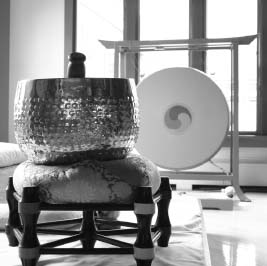BuddhismCustoms and Rituals |
What kinds of ritual objects figure in Buddhist worship and prayer? |
Among the most common implements used in regular ritual are acoustic devices such as bells, gongs, and hollow wooden blocks. Prayer leaders will occasionally strike a large bronze bowl-shaped bell set on a pillow. As its vibrant, mellow ring decays into silence, devotees recall the universal characteristic of impermanence. When ritual leaders, sometimes accompanied by the congregation, chant sacred texts, they generally strike a hollow block of wood rhythmically to keep chanters together in their recitation. Incense burners and containers of sand into which devotees can insert their lighted incense wands are part of nearly every ritual setting. Sometimes devotees will approach a temple’s large incense cauldron, waft the smoke toward themselves with their hands, and then rub it on various parts of their bodies for healing and general well-being. Esoteric sects typically employ a larger variety of objects. Tibetans use a small scepter symbolizing the indestructibility of the thunderbolt in one hand. The other holds a small bell whose vanishing sound represents impermanence. Some groups use weapons associated with Hindu deities who became part of the Buddhist pantheon. Some also use a begging bowl, as the Buddha did, or a fly whisk, symbol of adherence to the dharma. Most basic among the ritual objects in both home and temple are the candle holder (one for the home, two in temple), flower vase (one at home, two in temple), and small censer. Other common objects include tablets or scrolls containing sacred names or mantras, either in Sanskrit or the vernacular.

A gong and ritual drum at a Japanese Buddhist temple.
